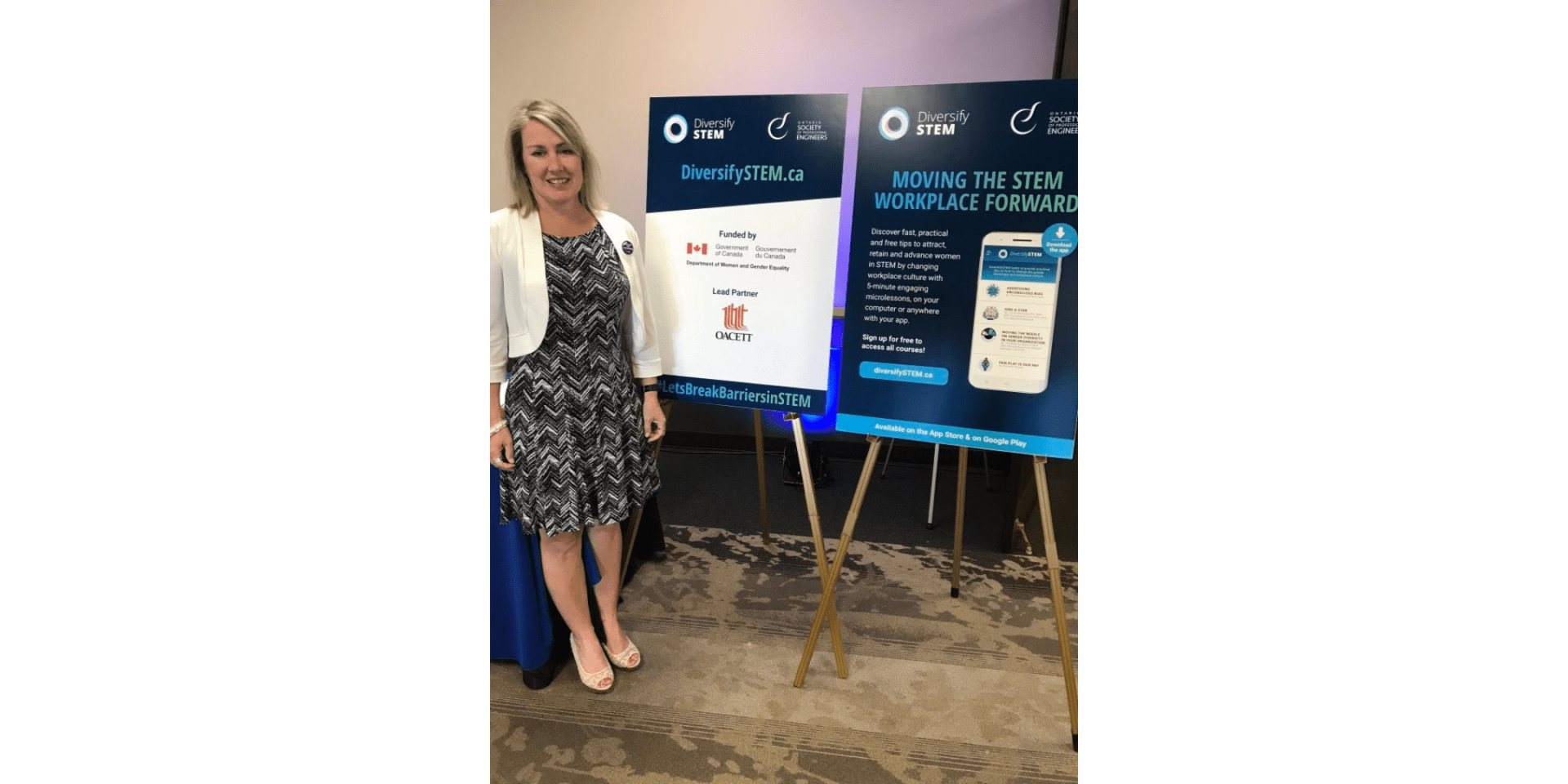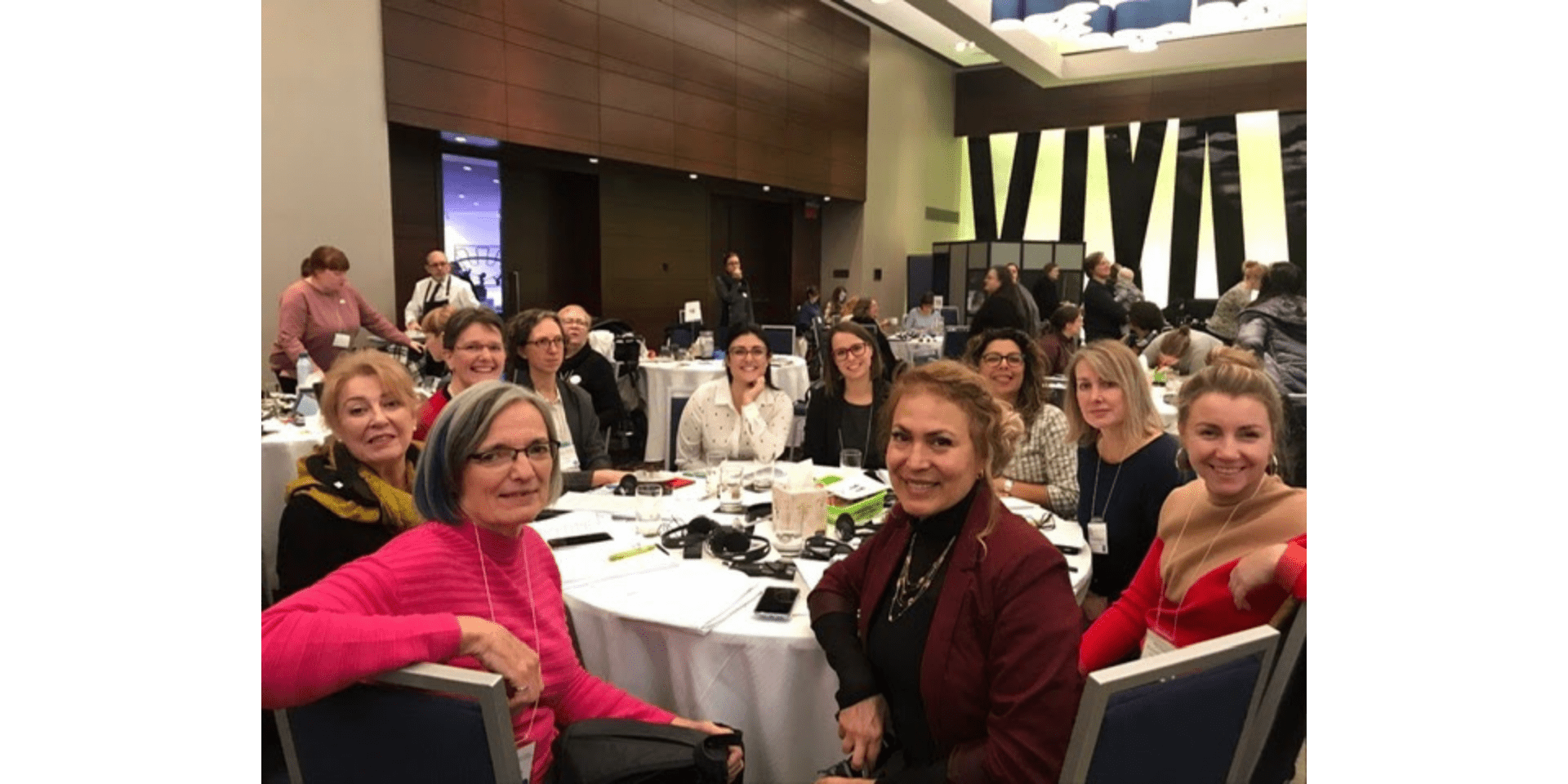Annette Bergeron: Leading by example in her advocacy for equity and inclusion
Back to Posts
By Alison Knill (Twitter: @alison_knill)
When Annette Bergeron started her undergraduate degree in the metallurgical engineering program at Queen’s University, she was one of two women. By the end of her degree, there were five people in the program and she was the only woman.
The small class sizes meant that they were a close-knit group of students, but it was also isolating for Annette.
“I didn’t have as much of a female community around me in my undergraduate degree, so you kind of assimilate yourself,” she said.
“You become one of the guys just to get along.”
The decline in female engineers Annette experienced with her classmates didn’t stop after post-secondary education. It continued as she went into industry, which is a phenomenon known as The Leaky Pipeline.
Annette continued from her undergraduate degree to her MBA. Her challenges in gender equity didn’t stop when she started graduate school, because she needed to balance her coursework with taking care of her newborn child.
She went back to class only one week after giving birth, which meant having to endure the difficulty of being away from her newborn for four hours.
“Now…I think it’s just much more acceptable to bring your infants into a classroom. If I had known then what I know now, I think that’s what I would have done,” she said.
“I think everybody should be able to bring their child into classrooms when they need to.”
Her MBA gave her the technical experience that she needed to excel in her career, but it was her undergraduate degree that motivated her advocacy work. Being in a male-dominated profession helped foster her passion for advancing gender equity and inclusion in STEM.
Creating DiversifySTEM
One major gender diversity project that Annette worked on was the DiversifySTEM app. The project started with a proposal from the Ontario Society of Professional Engineers.
The app became one of the 50 projects with the Gender Equality Network Canada, led by Annette, Valerie Davidson, Kathy Lerette, and supported by Tess O’Mara. The project started with research. What barriers were women in STEM experiencing? Where were the gaps in support?

They found a gap in support for women early in their STEM careers – that was the issue that their app would target. How could their app make a positive impact in the workplace?
“It’s really about changing the culture to make it more inclusive for women in STEM, and we thought, well, we’ll target the managers,” she said.
One thing they had to consider for managers, specifically, was time. Their users wouldn’t have much to spare.
Annette, Valerie, Kathy, and Tess found a solution by keeping the modules short. Micro lessons.
Keeping the content quick to consume resonated with their users. The tools had been used thousands of times within the first year, the app had 500 downloads, and the website platform had almost 20,000 views.
“We hope that someday inclusion [is a] part of everyone’s job, that it’s something that they do every single day, much like they do with safety in our day-to-day jobs,” she said.
Although the project has ended, the app and website are still available to continue promoting diversity in STEM workplaces. As a result of collaborative meetings with the SCWIST project Make DIVERSITY Possible, the DiversifySTEM micro lesson on mentoring features Make Possible – SCWIST’s Free mentoring network.
The importance of support, mentoring and leadership
Annette struggled, herself, with finding a strong support network early in her career. She was able to find support later in her career with networks like the GENC.
“We’re all still connected, we still communicate with each other,” she said.
“Learning about other women’s issues within GENC…the GENC touched on issues facing women across Canada, so learning about all those other aspects, the diversity of the women across Canada was fantastic.”

The 150 women leaders from across Canada met with a final goal in mind: a national action plan on gender equality. Their work culminated in a discussion document for a Pan-Canadian strategy to advance gender equality.
Alongside finding her own support, Annette’s been able to provide the mentorship and role models that she lacked in her early career. She provides mentorship through encouragement. Her support has helped several women achieve successful runs for council at Professional Engineers Ontario.
How does she act as a role model for young women in STEM? By taking the step into leadership roles to show others it can be done. Annette has served as President of Engineers Canada, Professional Engineers Ontario, and the Ontario Society of Professional Engineers. She also recently became the first woman Chair of the Electrical Safety Authority Board of Directors.
Annette joined the ESA board six years ago and during that time, she’s been able to support initiatives at the ESA to advance leadership inclusivity. As Board Chair, she’ll be able to continue championing the movement towards achieving more gender diversity.
“We women in STEM need, we need role models, we need leadership, we also need to bring that diversity within the boardroom so that everybody’s voice can be heard,” she said.
Spreading the advocacy message
When it comes to her personal goals, Annette’s focus is on “paying it forward” through mentorship and spreading messaging about equity and inclusivity.
Promoting and echoing voices has become part of her everyday routine.
“I’m continuing to volunteer, as a leader in the engineering community [and] as a role model to make sure that everyone’s voice is heard, to make sure that women are well represented in the STEM community and our profession,” she said.
Social media has been a big help for Annette when it comes to spreading her message. Even if she can’t physically be everywhere to talk about equity and inclusivity, her voice can be.
Annette does her advocacy work with the goal to remove the systemic barriers that women experience in STEM careers.
“One in four women in STEM still felt that they were facing barriers in their career,” she said.
Annette wants to get to a point where women are able to say that they don’t experience barriers in their STEM career. Then, Annette says,
“We will have succeeded.”
Want to join a diverse community of dynamic people who love STEM? Become a SCWIST Member.
Alison Knill is a graduate of the Master of Journalism program at UBC and is a former SCWIST Communications Intern. Have questions for Alison? Contact her via Twitter @alison_knill.